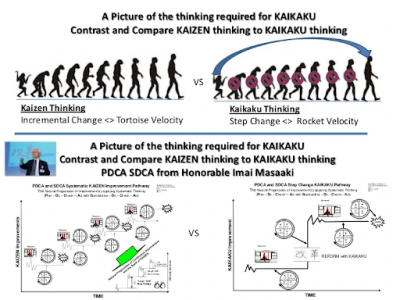In the Japanese language, Kaizen means “good change,” and Kaikaku means “radical change.” Since Kaikaku is a lesser known improvement tool in Lean Six Sigma (LSS), let’s learn more about what it means and how it works.
Overview: What is kaikaku?
Kaikaku and Kaizen are both concepts in Japanese production philosophy with their origins coming from the Toyota Production System (TPS). The concepts of Kaizen, Kaizen events and Kaizen Blitz are well known and frequently used in manufacturing, so we will not delve into them in this article.
While Kaizen is used for focused incremental change, Kaikaku strives for transformational change. This implies a radical redesign of business processes reaching across an entire organization. Kaikaku events are generally cross-organizational, and can take months to complete rather than the typical 5 day Kaizen event. Whereas Kaizen events are narrowly focused on a single element of a process, Kaikaku events will often span multiple functions and organizations. Despite being more expansive, the impact of Kaikaku events can be immediate.
The graphic below illustrates the difference in thinking between Kaizen and Kaikaku.

An industry example of kaikaku
A large manufacturing company invited a Lean consultant from Japan to visit their 5 US sites. The company was about to embark upon a major SAP implementation and, based on previous experiences implementing large long range projects, the company’s President asked if the consultant had any recommendations.
He suggested the company consider following Hiroyuki Hirano’s Ten Commandments of Kaikaku. By doing so, he felt the company could significantly reduce the time needed to make the change. Here are the 10 Commandments:
- Throw out the traditional concept of manufacturing methods.
- Think of how the new method will work; not how it won’t work.
- Don’t accept excuses.
- Totally deny the status quo, be ready to start new.
- Don’t seek perfection. A 50% implementation rate is fine as long as it is done on the spot.
- Correct mistakes the moment they are found.
- Don’t spend money on Kaikaku.
- Problems give you a chance to use your brains.
- Ask “why” five times.
- Ideas from ten people are better than one person’s knowledge.
- Kaikaku knows no limits.
The 10 Commandments of Kaikaku
By doing as was suggested, the company was able to reduce their planned implementation by almost 60%.
Frequently Asked Questions (FAQ) about kaikaku
1. What is the difference between a Kaizen and Kaikaku event?
Kaizens are of short duration, less complexity and focused on incremental, evolutionary improvement. Kaikaku events will result in dramatic, radical and revolutionary change where the changes are felt quickly and across wider swaths of the organization.
2. Will the radical change of Kaikaku always cost money?
The seventh commandment of Kaikaku is important because it says “Don’t spend money on Kaikaku.” Kaikaku isn’t about buying new technology or equipment. Kaikaku is about thinking and doing things in a new way.
3. Is Kaikaku part of the Toyota Production System?
Yes, its origins are linked to the Toyota Production System developed by Sakichi Toyoda and Taiichi Ohno of Toyota.